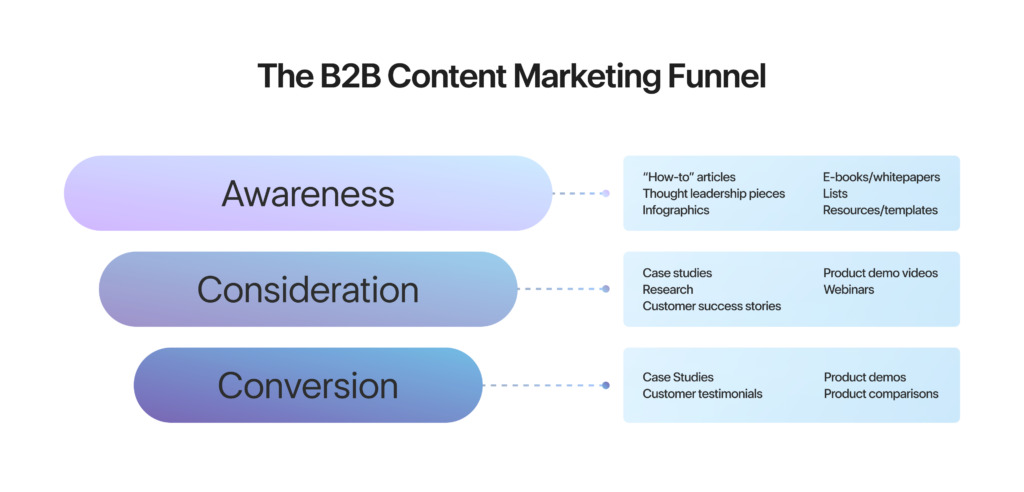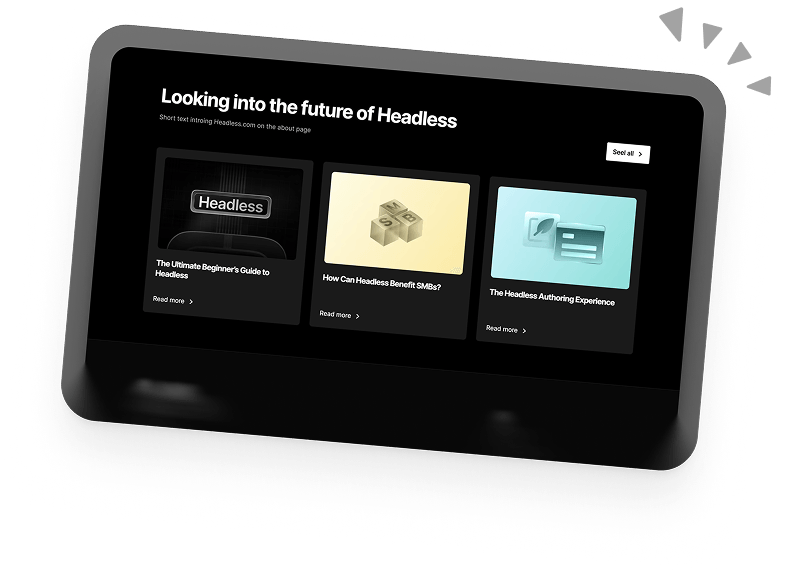B2B SaaS Marketing Strategy: The Complete Guide
In the whirlwind that is B2B SaaS, businesses need to find that little extra something to help them stand out from the crowd. Typical marketing strategies – or even B2B-specific ones – won’t always work. B2B SaaS marketing strategies demand a nuanced approach.
That doesn’t mean we have to reinvent the wheel, of course. But, it’s important to understand where B2B SaaS marketing differs from other fields. The first step in any great strategy is knowing what you’re up against.
This article has two main sections.
Part 1 is all about getting to grips with the defining features of B2B SaaS marketing and understanding the challenges it poses.
In Part 2, we’ll get into the nitty-gritty of it and explore some practical strategies that can enhance your marketing strategy.
And so, without further ado, let’s dive right in.
Part 1: What differentiates B2B SaaS Marketing?
Marketing for B2B SaaS companies comes with its own set of challenges. So, before we get into the specifics of your marketing strategy, let’s look at some of the things that make B2B SaaS marketing unique.
Target Audience
When dealing with B2B SaaS buyers, you’re not working with just anyone. Your audience is going to be well-informed, experienced in their industry and have a clear picture of what they want. Before making a purchase, B2B buyers will spend a lot of time researching their options so they’ll already be familiar with the competition.
A few flashy marketing comments won’t cut it here. You need to go above and beyond to show them why your software is worth it.
Beyond just knowing if your product works well or not, they want to know what you can offer them that your competitors can’t. The B2B SaaS market is highly competitive, and your customers know it.
Longer Sales Cycle
B2B SaaS is a marathon, not a sprint. When dealing with industry experts, you’re not going to find people buying on the same day. Your customers are careful, meticulous, and far from impulse buyers. Instead, you’re looking down the barrel of a much longer sales cycle.
On average, the process of moving a new customer from their initial point of contact with your brand to a sale takes around 4-6 months.
It’s also important to remember that SaaS isn’t a one-and-done deal. With all subscription models, you need to constantly prove your worth to your customers. The moment you start flaking on promises or under-delivering, they’ll start looking for another software package to take your place.
Messaging
If B2B SaaS buyers are anything, they’re informed. They’ll enter into conversations with you with a comprehensive knowledge of your competitors, your product, and your offerings.
What they don’t know yet is how they can take your software and turn it into productivity or profit gains for their company.
In your marketing, speak directly to pain points you can solve and how your product can enhance their business. As you’re likely going to deal with entire organisations, rather than individual customers, it’s important to speak to comprehensive and broad solutions.
B2B SaaS is a fiercely competitive market. To stand out, you need to know what makes your company truly worth it to a potential buyer. Start with your strengths, and go from there.
Understanding the SaaS Marketing Funnel
As with all marketing funnels, SaaS marketing touches on a few core stages.
No matter the industry, you’re going to move through the following stages of the marketing funnel:
- Awareness: The first touchpoint between your brand and a customer and their introduction to your business.
- Consideration: Customers compare your brand to other available options and find advantages.
- Conversion: When a customer makes the first purchase with your business.
What sets SaaS marketing apart is that there are several other phases a customer goes through. The SaaS marketing funnel includes these additional stages:
- Onboarding: When a business chooses your SaaS brand, you’ll have to onboard their organisation to your software. This process could be through tutorials or alongside help from customer success reps.
- Adoption: Remember, SaaS brands need to constantly demonstrate the value of their product. With that in mind, the adoption phase is about making businesses love your product. You’ll attempt to drive engagement, solve any user issues, and teach people how to get the most from your product.
- Renewal: As your initial contract draws to its close, you need to vie for a re-subscription. At this stage, you’ll need to focus on retaining customers. You’ll have to monitor metrics for signs of customer churn and carry out your customer retention strategy (more on that later).
- Expansion: Why stop at just one package? If you have a strong relationship with a brand, you can focus on cross-selling or upselling new products and features. Offer businesses the chance to scale their use of your product as they grow.
While a purchase is the final goalpost for most businesses – this stage is only the beginning for B2B SaaS.
What tools do I need for B2B SaaS Marketing?
If you’re running a SaaS business, we probably don’t need to sell you on just how important your choice of technology is.
Tech runs the B2B SaaS marketing world. It helps you align customer data, personalise interactions, and generally keep your customers happy.
In fact, according to a 2022 study by Insightly, 36% of companies with fully aligned tech stacks for customer data experienced a significant increase in revenue.
Here are the top tools that you need for effective B2B SaaS marketing:
- Content Management System: The larger your business grows, the more content you’ll have to manage. CMS platforms offer a streamlined solution that helps you create, publish, and organize your content.
- Customer Relationship Management Platform: You know what doesn’t make a great impression? Forgetting a customer’s name, role, or even a previous interaction they’ve had with your team. CRM platforms keep all your ducks in a row and allow for seamless customer communication.
- Customer Success Management Software: Customer Success Management (CSM) tools are an essential part of delivering a great customer experience. CSMs are all about keeping your clients happy, boosting retention, and reducing churn.
- Analytics: We all know just how important data is to the world of marketing. Analytics tools give you data-driven insights that can inform and enhance just about every aspect of your marketing strategy.
- Email Automation Software: Email marketing offers a ROI of up to £42 for every £1 spent. With ROI like that, email isn’t a marketing stream you can afford to overlook. Email automation software will increase your ability to deliver content, personalise emails, and score leads.
- Content Research Tools: 55% of survey respondents state that article content is the leading content form that moves them through the B2B funnel. By utilizing keyword research tools, your business can create content that connects with your audience.
- Conversion Rate Optimisation Tools: Running A/B testing, optimising customer-facing pages, and improving conversion over time will help your business improve your bottom line.
- Ad Management Platforms: Finally, for brands that want to focus on pay-per-click marketing, ad platforms are vital.
Part 2: Essential B2B SaaS Marketing Strategies
Now that we’ve gotten to grips with the intricacies of B2B SaaS marketing, it’s time to look at some of the most important steps you can take to enhance your marketing strategy.
Develop content for every touchpoint in the marketing funnel
Depending on where your customer finds themselves on their journey, their understanding of your brand will vary. Of course, a long-term client isn’t going to need the same content as someone who’s never heard of your company before.
With that in mind, it’s useful to develop content for every touchpoint across the marketing funnel. B2B SaaS businesses can split the funnel into three core areas:
- TOFU Content – Top-of-the-funnel content refers to the content you create to raise general awareness about your business. We’re talking blog posts, e-books, podcasts, and social media updates.
- MOFU Content – You aim middle-of-the-funnel content at users who are already fairly familiar with your business, but haven’t yet made a purchase. Winning content at this level is about showing what your content can do with educational content, webinars, events, and downloadable resources.
- BOFU Content – Finally – as you can guess – bottom-of-the-funnel content is aimed at customers on the verge of conversion. In B2B SaaS, BOFU content is all about sales demos, customer reviews and stories, and hitting home why you’re the brand to choose. This type of content is also crucial for retention as it reinforces the value of your product(s) to existing customers.

Always develop content for all three touchpoints. No one point should be more important than the others. Each offers a unique function and will help move people along their customer journeys. Optimising your content strategy over time can pay off in dividends.
Optimise your website structure
If you want customers to trust your brand, you’ve got to look the part. Most of the time, your website is going to be people’s first impression of your company. So, optimising your website is a good way to put your best foot forward.
Here are some considerations to include:
- Include CTAs where you can
- Supply lead capture forms where possible
- Provide social proof and case studies
- Offer product demos to show off your product(s)
Part of site optimisation should also be building accessibility for mobile users. Four out of five B2B decision-makers use their mobile to conduct business. Accommodating for this segment will prepare you nicely for the future.
Remember to specifically build for the B2B SaaS market you deal with. Where you can, focus on concrete evidence, hard data, and showing why your brand delivers value.
Segmentation and personalisation
Digital marketing thrives on personalised content. Without the ability to offer your audience a personalised experience, they’ll likely find another option. In fact, 65% of B2B buyers switch providers if they don’t receive a personalised service.
An effective way of building personalisation into B2B SaaS marketing campaigns is to focus on segmentation. By splitting your user base into smaller groups, you can cater to individual segments with a higher degree of personalisation.
Although we all realise how important personalisation is at this point in the game, it’s not always easy to get it right. Turns out that 63% of digital marketers still struggle to deliver personalised experiences.
Using segment analytics, you can discover what each user group likes best. From there, you can provide tailored services that address their pain points.
Focus on retention
You can’t go five minutes into the world of marketing without hearing the age-old statistic that acquiring a new customer costs five times as much as selling to a current one. While we might be a little burnt out on that fact, it’s stayed around for so many years due to how important it is. For any business looking for long-term success, retention should be the number one priority.
For B2B SaaS businesses, retention is even more serious. As a subscription-based model, you need to ensure customers stay your customers for as long as possible. Here are some B2B SaaS retention strategies you can try out:
- Make sure that support is always available and any issues are addressed quickly.
- Personalise interactions, both online and face-to-face.
- Maintain regular communication with your customers.
- Identify opportunities for growth where your product can be useful.
- Implement loyalty and incentive programs.
- Cross sell and upsell new features.
- Monitor metrics for indications of customer churn.
Another useful approach can be gathering customer success metrics. Net Promoter Scores, customer satisfaction surveys, and customer effort scores all provide effective baseline data that measure the customer experience.
B2B SaaS is a rapidly changing industry, meaning that regular measuring is the way to go here. Give your customers as many opportunities as possible to give feedback and to see that you’re taking action based on their comments.
In order to carry out all these strategies, you’ll need to have a dedicated customer success management team. With a CSM team you can enhance a client’s experience of your product and keep them coming back for more.
Wrapping Up
B2B SaaS marketing is a challenging field – but not one that’s impossible to get ahead in. With the strategies we’ve outlined on this list, your business can build up a winning approach for 2024 and beyond.
Book a 30-min Introduction Call
Let's jump on a quick intro call We'll break down your project, and pinpoint exactly how we can help.



Our clients  Holaa! love working with us see their stories below!
Holaa! love working with us see their stories below!






